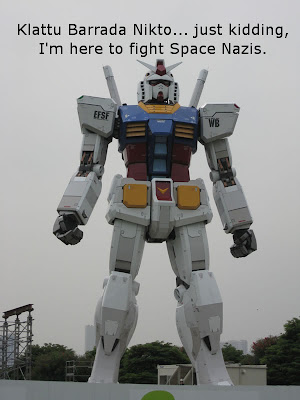No, really, I've had overtime over the course of the month. Work! Lots of it. I love my job, but it's still a job and sometimes it requires something above 8 hours a day.
But, I've also been playing Monster Hunter Freedom Unite. Also known as Monster Hunter Portable 2G. A game most people have never heard of, that topped Japanese sales charts for all of 2008. It was released March of 2008, in Japan. In America, it came out June of 2009. I have been waiting MORE than a YEAR for this game to come out. And I already own it.
Each year a "new" M3 is released. But year to year, the changes in various models are not substantial. New parts are used that cut the manufacturing costs, new technologies are implemented to improve gas mileage and emissions, etc. Once in a long while, the car's basic design is overhauled. Back in 1989 a new M3 would be an "E30" M3, because E30 represented the body design and manufacturing standard. In 1997, a new M3 would be an "E36" which, while still representing BMW's chief mass-market sports car, is essentially a totally new design. The two cars would look only vaguely alike, mainly because cars usually have four wheels, windows, a grill in front and a trunk in back. Usually.
Similarly, Monster Hunter games are released once every year or two (the first came out in 2004). After the initial release, a special upgraded version called "Monster Hunter G" was released. The Japanese sometimes tack G into game titles to denote something is stronger or better - I'm not sure why, but I've been told that sometimes it's to invoke the word "God" which represents power and strength to the Japanese. Not sure myself. Monster Hunter G was EXACTLY the same game as Monster Hunter. Same monsters, same areas, same items, everything. With two exceptions: One, they added "extra" monsters - all of which were simply old monsters with new colors. The fire breathing dragon, for example, was normally red, but in "G" you could fight a BLUE one, because blue flames burn hotter than red. Neat huh?
The OTHER thing they added was a new set of weapons. Not a new weapon, but an extra set of about 40 weapons. These weapons were "dual swords", basically large daggers sets, wielded one in each hand. The original game had Sword and Shield weapons, HUGE swords called Great Swords, giant Hammers, large spears called Lances (always paired with a shield) and finally, "bowguns" which are guns, that propel ammo by way of… a bow string. The addition of dual swords effectively increased the number of weapons by 20%.
After the first two, Capcom released a true sequel, called Monster Hunter 2 Dos (Dos being… Spanish for 2). The sequel added… more monsters. Crabs and monkeys. GIANT crabs and monkeys. It also featured new versions of all the original game areas. And new weapons. But the core game remained the same. Later they released Monster Hunter Portable, a version of the first game for the PSP (actually a version of Monster Hunter G, but they left the G out). After Portable came Portable 2, a PSP version of… you guessed it, Monster Hunter 2 Dos.
Every game released so far has been like this. Take the original formula - and change NOTHING. Change the art slightly. Change the monsters - just their color maybe, or add something new, even if it behaves similarly to the old monsters.
Fuel Injection. Carbon hood, carbon roof. Power Steering, Power Brakes, Power Seats. HEATED Seats.
No one reinvents the car, not a regular basis - the closest we've come are hybrids and pure-electrical automobiles. Similarly, Monster Hunter never needed any of its core mechanics to change. The original was one of the biggest sellers on the Japanese Playstation 2 system. The sequel never came out on home systems in America, because by the time the game would have been ready, the Playstation 2 was being replaced by the Playstation 3 (… at least Sony would like you to think so. Technically the Playstation 2 has outsold the Playstation 3 every year since the PS3 came out) so instead, they "ported" the game to the PSP.
I own every version of Monster Hunter released in North America. So while I had been waiting for Monster Hunter Freedom Unite (the American name of Monster Hunter Portable 2G) for over a year, I'd also been playing it THE WHOLE TIME.
Sound crazy? Maybe. But ask the owner of a BMW M3 if they'd like to keep their old car or trade up to the new one. Most are going to say, "Can't I just have both?"
Jeeze look at all that text. And I didn't even explain what the game is about! Next time, and with more pictures.







